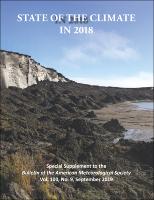Mostrar el registro sencillo del ítem
Heavy Snowfalls in the peruvian Andes: the wettest winter of the last 19 years
| dc.contributor.author | Ramos, Isabel | |
| dc.contributor.author | Aliaga Nestares, Vannia | |
| dc.contributor.author | Castro, Anabel | |
| dc.date.accessioned | 2020-02-25T22:02:45Z | |
| dc.date.available | 2020-02-25T22:02:45Z | |
| dc.date.issued | 2019-09 | |
| dc.identifier.citation | Ramos, I.; Aliaga-Nestares, V y Castro A. Y. Heavy Snowfalls in the peruvian Andes: the wettest winter of the last 19 years. [in “State of the Climate in 2018”]. Bull. Amer. Meteor. Soc., 100 (9), SI-203-221. doi:10.1175/2019BAMSStateoftheClimate.1. | es_PE |
| dc.identifier.uri | https://hdl.handle.net/20.500.12542/276 | |
| dc.description.abstract | Most meteorological stations in the central and southern Peruvian Andes also received heavy rainfall in June and July. On 2 June, Ananea, which is located in Puno at 4660 m a.s.l., recorded 32.5 mm (monthly climatology is 8.4 mm), and Sicuani, located in Cusco at 3574 m a.s.l., accumulated 13 mm on 21 July (monthly climatology is 3.7 mm). The many precipitation events were associated with the entrance of troughs and cut-off lows from midlatitudes and by the increased moisture flux in the low and middle levels of the atmosphere (Quispe 2017; Quispe 2014; Quispe and Avalos 2006; Vuille and Ammann 1997). In the composite upper-tropospheric (250 hPa) analysis of seven snowfall events (Fig. SB7.5), an anomalous trough over the Pacific Ocean with the divergent side of the jet stream over southern Peru and an incursion of cold air created an optimal environment for the development of convective storms in the southern Andes of Peru, all of which are most likely to occur in the afternoon and night. Meanwhile, in the mid-troposphere, composites of daily mixing ratio analysis at the 500-hPa level (Fig. SB7.5) during all 2018 snowfall events show anomalous moisture over the central and southern Peruvian Andes, associated with an anomalous localization of a trough over the eastern Pacific Ocean near Peru. These conditions appeared farther north than their normal position, generating advection of cold air. In most of the snowfall events, these troughs evolved into a cut-off low over the Pacific Ocean. Of the seven strong and moderate snowfall events considered here, four were associated with the development of a cut-off low over the Pacific Ocean near Peru. This was the main factor that generated snow over the Peruvian Andes in the winter. One of these cut-off low events caused hail and electric storms in the central coast of Peru on 20 July. Overall, the snowfalls of 2018 affected over 300 000 people, and roads and highways were inaccessible in several regions due to the accumulated snow. Cattle raising was affected because snow covered and damaged the pastures, causing many of the animals to starve; official numbers indicated more than 25 700 sheep and 45 200 camels were lost. | es_US |
| dc.format | application/pdf | es_PE |
| dc.language.iso | eng | es_PE |
| dc.publisher | American Meteorological Society | es_PE |
| dc.relation.ispartof | urn:issn:1520-0477 | |
| dc.rights | info:eu-repo/semantics/openAccess | es_PE |
| dc.rights | Reconocimiento - No comercial - Sin obra derivada (CC BY-NC-ND) | es_PE |
| dc.rights.uri | https://creativecommons.org/licenses/by-nc-nd/4.0/ | es_PE |
| dc.source | Repositorio Institucional - SENAMHI | es_PE |
| dc.source | Servicio Nacional de Meteorología e Hidrología del Perú | es_PE |
| dc.subject | Cambio Climático | en_US |
| dc.subject | Climatología | en_US |
| dc.subject | Perú -- Andes Centrales | en_US |
| dc.title | Heavy Snowfalls in the peruvian Andes: the wettest winter of the last 19 years | en_US |
| dc.type | info:eu-repo/semantics/article | es_PE |
| dc.identifier.isni | 0000 0001 0746 0446 | |
| dc.description.peerreview | Por pares | es_PE |
| dc.identifier.doi | https://doi.org/10.1175/2019BAMSStateoftheClimate.1. | |
| dc.identifier.journal | American Meteorological Society - AMS | es_PE |
| dc.source.volume | 100 | es_PE |
| dc.source.issue | 9 | es_PE |
| dc.subject.ocde | https://purl.org/pe-repo/ocde/ford#1.05.10 | es_PE |
| dc.subject.sinia | variabilidad climatica - Clima y Eventos Naturales | es_PE |
| dc.type.sinia | text/publicacion cientifica | es_PE |
| dc.identifier.url | https://hdl.handle.net/20.500.12542/276 | |
| dc.identifier.url | https://hdl.handle.net/20.500.12542/276 |
Ficheros en el ítem
Este ítem aparece en la(s) siguiente(s) colección(es)
-
Artículo científico [176]









